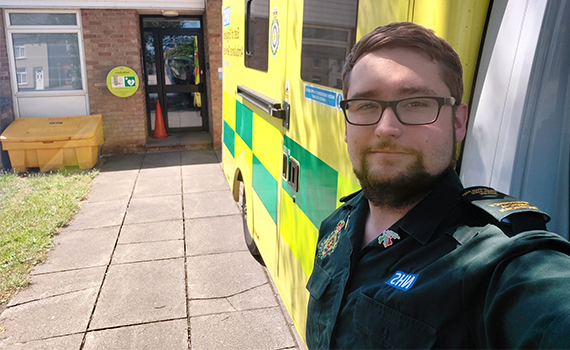Albert's story for National Apprenticeship Week
Date: 10 February 2023
Time: 10:00

This National Apprenticeship Week, we’re talking to members of #TeamEEAST who started their career with us as an apprentice and hearing about their journeys.
Today we’re talking to Albert Churchouse, a senior emergency medical technician (EMT) working from central Cambridgeshire.
Introduce yourself!
My name is Albert Churchouse, and I am a senior EMT working out of central Cambridgeshire!
What apprenticeship did you do?
I did the emergency medical technician apprenticeship with the East of England Ambulance Service NHS Trust (EEAST).
Why did to choose to take the apprenticeship route?
For me the apprenticeship route was a fantastic way to progress into the ambulance service without the requirement of going to university beforehand. The apprenticeship route provides the ability to learn on the job with practical application being at the forefront of training which perfectly suited me.
How does the application process work?
The application process is quite simple. I applied online following a recommendation from a friend for the course via the TRAC website. At the time, you required your C1 licence to apply alongside any previous experience which they like to know about. I then progressed into interviews and an assessment day where they discussed what joining EEAST would look like. Once successful, I was then informed of where I would start via email.
What does the apprentice journey look like?
My apprentice journey started initially with a 12-week clinical training course at the training centre in Newmarket. The 12-week training included a variety of different subjects and practical training that teaches the basic knowledge in preparation for you to be safe on the road as an apprentice EMT.
You are taught both in classroom lessons and in practical assessments which teach you a variety of subjects from anatomy and physiology, to how to handle the scene at cardiac arrests or maternal emergencies. After having weeks of training, you take several written exams on medicine, anatomy and pathophysiology to test and solidify your knowledge. This happens alongside practical exams that you take with the training team which assess your competence to handle the emergencies from a practical point of view.
After the initial 12 weeks in training school, you then start your hours on the road at your base station that’s agreed in the process. You are then required to complete 750 hours on the road whilst working as a crew. As well as working frontline and attending jobs as a double crew, you also are also required to complete a portfolio which is signed by a qualified member of staff after they witness you safely completing a clinical skill out on the road. You also do a larger portfolio consisting of workbook related content and self-reflections.
How did you find the apprenticeship experience?
Due to COVID-19 and other complications my apprenticeship took quite a while to fully complete, however, that hasn't stopped my progression to senior EMT. The process and application was simple and I have been supported by our local mentor team to get me to where I am. I am extremely lucky to have good management, mentors and crew local to me!
Would you recommend an apprenticeship to other people?
For those wanting to train and experience life on the road as a clinician making life or death decisions in high pressure situations, but think university isn't the right path, then YES! The apprentice route is one filled with amazing opportunities and is a fantastic way to start your journey into the world of the ambulance service.
Talk us through your journey from starting as an apprentice to working your way up to senior EMT.
I started my apprentice journey just before the start of COVID-19, over the course of the following two years with lots of support and training I got to help the NHS at a time where it was needed most. The journey hasn't been easy, but it’s been one of the most rewarding career changes of my life. Once I had completed my 750 hours within the Trust, as well as my portfolio and workbook, I was put forward for my 12 month ride out (where a mentor reviews your progress and sees if you are a competent EMT and safe to be running the show!) Following this you are put forward for your end point assessment (EPA). Once you pass the EPA you are qualified as an EMT and you will be put with lots of new apprentice EMTs and other crew members such as emergency care assistants (ECAs)aramedics or emergency care support workers (ECSW).
After continuing further training sessions and eventually attending a mentoring course, you progress to senior EMT where you will then gain experience in the role to begin to help mentor and support new staff entering the trust. Eventually you can then look at going to apprentice paramedic, a route I intend to start at the end of this year!
- Summary:
This National Apprenticeship Week, we’re talking to members of #TeamEEAST who started their career with us as an apprentice and hearing about their journeys.
